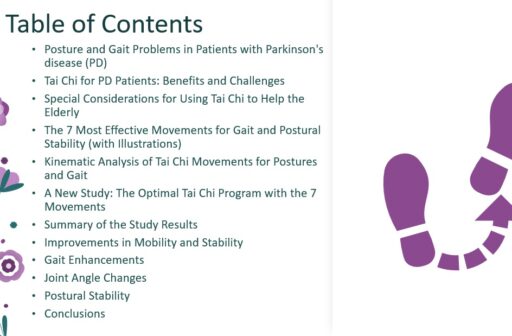Unveiling the Benefits of Tai Chi for Parkinson’s Disease
Parkinson’s disease (PD) is a progressive neurological disorder that profoundly affects gait and postural stability, leading to increased risks of falls and decreased quality of life. Tai Chi, a mind-body exercise known for its gentle movements and balance-focused practices, has been recommended as a beneficial intervention for managing PD symptoms.
However, the biomechanical mechanisms behind its effects on gait and postural stability have remained largely unexplored—until now.
A new study conducted by the School of Human Kinetics at the University of Ottawa has shed light on how a biomechanical-based Tai Chi intervention using only seven of the Tai Chi forms can significantly improve gait and postural stability in individuals with early-stage PD. This study offers new and practical insights for incorporating Tai Chi into PD management strategies.

A tutorial with details is available for ATCQA Members and Certified Instructors/Practitioners.
Study Overview
Fifteen participants with early-stage PD were recruited for this 12-week intervention study. The Tai Chi program includes the 7 forms that have been proved by past studies to be the most beneficial to improve gait and postural stability. The program consisted of 60-minute sessions, held three times a week, designed to enhance both the physical and mental well-being of the participants. Pre- and post-intervention assessments included obstacle crossing, the timed-up-and-go (TUG) test, and single-leg standing (SLS) tests with eyes open and closed.
Key Findings
Significant Improvement in Gait and Postural Stability
The study revealed that the 12-week Tai Chi intervention led to substantial improvements in various measures of gait and postural stability:
- TUG Test Performance: Participants significantly improved their TUG test performance, indicating enhanced mobility and functional independence.
- Obstacle Crossing: During obstacle crossing, participants exhibited a significant increase in crossing stride length of the trailing foot, greater anterior-posterior (AP) center of mass (COM) displacement and reduced medial-lateral (ML) COM-center of pressure (COP) separation. These changes suggest improved dynamic stability and more confident, longer strides while navigating obstacles.
- Joint Angle Adjustments: The maximal dorsiflexion angle of the leading limb significantly increased, while the maximal plantarflexion angle of the trailing limb significantly decreased. These adjustments contribute to a smoother and more stable gait pattern.
Practical Applications and Future Directions
The success of this biomechanical-based Tai Chi program highlights its potential as a practical and effective intervention for managing PD symptoms. The online format ensures accessibility, allowing individuals to practice Tai Chi from the comfort of their homes, which is particularly beneficial during times when in-person classes may not be feasible.
These findings pave the way for future research and the development of tailored Tai Chi programs specifically designed for PD patients. Clinical trials will be essential to further establish the effectiveness, safety, and optimal dosage of Tai Chi for improving gait and postural stability in this population.